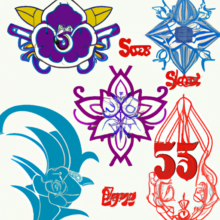Minimizing The Pain Of Tattoos
Tattoos have become increasingly popular in recent years, with more and more people choosing to get inked as a form of self-expression. However, one of the biggest concerns for those considering a tattoo is the pain that comes with it. While some may say that the pain is just part of the process, there are ways to minimize the discomfort and make the experience more bearable. In this article, we will discuss some tips and techniques for minimizing the pain of tattoos.
1. Choose the Right Placement
One of the most important factors in minimizing the pain of a tattoo is choosing the right placement. Areas with more fat and muscle, such as the thighs, upper arms, and calves, tend to be less painful than areas with less fat and more bone, such as the ribs, feet, and hands. It’s also worth considering the sensitivity of the skin in different areas of the body. For example, the skin on the inner arm is generally more sensitive than the outer arm. By choosing a less sensitive area, you can significantly reduce the pain of getting a tattoo.
2. Stay Hydrated and Well-Rested
Before getting a tattoo, it’s essential to make sure you are well-rested and hydrated. Dehydration can make the skin more sensitive, which can increase the pain of getting a tattoo. On the other hand, being well-rested can help you relax and make the experience more comfortable. Make sure to drink plenty of water in the days leading up to your appointment and get a good night’s sleep before your tattoo session.
3. Numb the Area
Another way to minimize the pain of tattoos is to numb the area beforehand. There are several numbing creams and sprays available that can help reduce the pain. These products contain lidocaine, a local anesthetic that numbs the skin. It’s essential to follow the instructions carefully and apply the numbing product at least an hour before your tattoo appointment for it to be effective.
4. Distract Yourself
Distraction can be a powerful tool in minimizing the pain of tattoos. Some people find that listening to music, watching a movie, or chatting with the tattoo artist can help take their mind off the pain. You can also try deep breathing exercises or meditation to help you relax and focus on something other than the discomfort.
5. Take Breaks
If you’re getting a large or detailed tattoo, it’s essential to take breaks during the session. This will give your body a chance to rest and recover, making the experience more bearable. You can also use this time to stretch, hydrate, and reapply numbing cream if needed.
6. Choose a Skilled Tattoo Artist
The skill and experience of the tattoo artist can also play a significant role in minimizing the pain of tattoos. A skilled artist will have a light touch and work quickly, reducing the time you spend in discomfort. They will also be able to advise you on the best placement and techniques to minimize pain.
7. Stay Calm and Relaxed
It’s natural to feel nervous or anxious before getting a tattoo, but it’s essential to stay calm and relaxed during the process. Tensing up or moving around can make the pain worse and make it more challenging for the artist to work. Try to focus on your breathing and stay as still as possible.
8. Aftercare is Key
Minimizing the pain of tattoos doesn’t end when the session is over. Proper aftercare is crucial in reducing discomfort and promoting healing. Follow the aftercare instructions provided by your tattoo artist, which may include keeping the area clean, applying ointment, and avoiding certain activities that could irritate the tattoo.
In conclusion, getting a tattoo doesn’t have to be an excruciating experience. By choosing the right placement, staying hydrated and well-rested, numbing the area, distracting yourself, taking breaks, choosing a skilled artist, staying calm and relaxed, and following proper aftercare, you can minimize the pain of tattoos and make the experience more enjoyable. Remember, the pain is temporary, but the beautiful artwork on your skin will last a lifetime.



